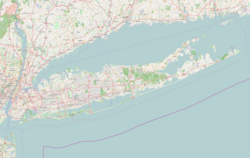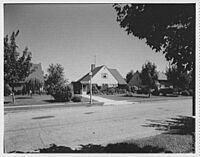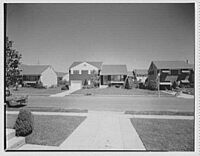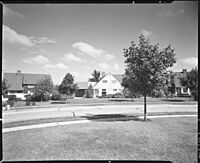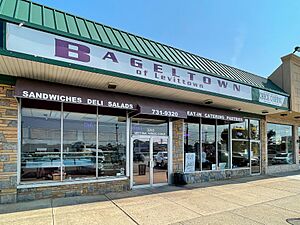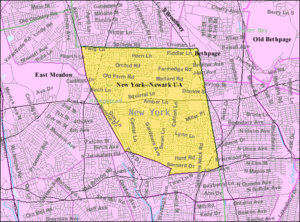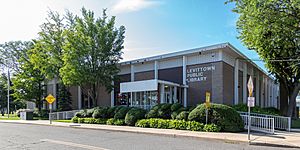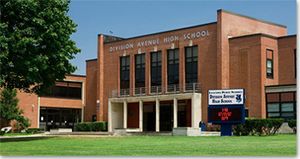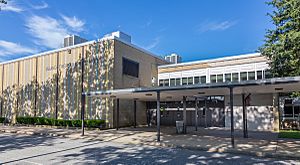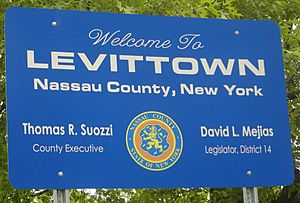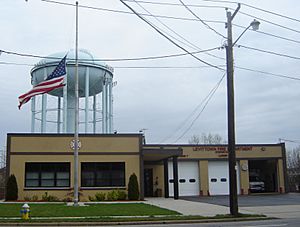Levittown, New York facts for kids
Quick facts for kids
Levittown, New York
Island Trees, New York
|
|
|---|---|
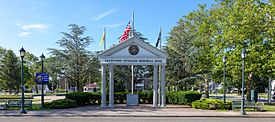
Levittown Veterans Memorial Park
|
|
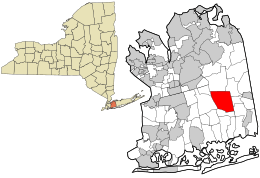
Location in Nassau County and the state of New York.
|
|
| Country | |
| State | |
| County | Nassau |
| Town | Hempstead |
| Named for | Levitt & Sons |
| Area | |
| • Total | 6.84 sq mi (17.71 km2) |
| • Land | 6.81 sq mi (17.64 km2) |
| • Water | 0.03 sq mi (0.06 km2) |
| Elevation | 82 ft (25 m) |
| Population
(2020)
|
|
| • Total | 51,758 |
| • Density | 7,598.06/sq mi (2,933.51/km2) |
| Time zone | UTC−5 (Eastern (EST)) |
| • Summer (DST) | UTC−4 (EDT) |
| ZIP Code |
11756
|
| Area codes | 516, 363 |
| FIPS code | 36-42081 |
| GNIS feature ID | 0955234 |
| Website | www.levittown.li |
Levittown is a community in Nassau County, on Long Island. It is known as a hamlet and a census-designated place (CDP). This means it's a small community that is part of a larger town, but not an official city or village. Levittown is a suburb of New York City. It is located between the villages of Hempstead and Farmingdale. In 2020, about 51,758 people lived there. This makes it one of the largest CDPs on Long Island.
Levittown got its name from the company that built it, Levitt & Sons. This company was started by Abraham Levitt in 1929. His sons, William and Alfred, helped build Levittown as a special planned community. It was made for soldiers returning home after World War II. Construction happened between 1947 and 1951. Levittown was one of the first places to use mass-production methods for building homes. It became a model for many other suburbs across the United States. William Levitt is often called the "father of modern suburbia."
People have suggested in the past that Levittown should become its own village or even a city.
Contents
History of Levittown
How Levittown Began
The company Levitt & Sons built four planned communities named "Levittown." The first one was in New York. Others were in Pennsylvania, New Jersey, and Puerto Rico. Before World War II, Levitt & Sons built custom homes. But during the war, William "Bill" Levitt learned how to build many homes quickly for the Navy.
After the war, Bill Levitt convinced his family to use these fast building methods. His brother, Alfred, designed a small, one-story house with an attic that could be finished later. These homes were built very quickly and cheaply. By July 1948, they were building 30 houses a day! They used pre-cut wood and nails from their own factories. They also built homes on concrete floors, which was a new idea at the time.
Levitt & Sons sold these homes for around $8,000. This included modern kitchen appliances and even a television. With help from the G.I. Bill and government housing programs, many buyers only needed about $400 upfront. This made homeownership possible for many families.
At first, the homes were rented. But because so many people wanted to live there, Levitt & Sons started selling them. They offered 30-year mortgages with no down payment. This made it even easier for families to buy a home. The community, originally called Island Trees, soon changed its name to Levittown. It quickly became a symbol of the "American Dream" for many families.
Ideas for Levittown to Become a City
In 1952, a politician named Carl Sigman suggested that Levittown should become its own city. If this had happened, it would have been the third city in Nassau County. Before this, local people had also thought about making Levittown an official village.
Important Changes Over Time
Levittown became a symbol of the "American Dream," but it also showed a problem in America at the time. Early rules for buying homes in Levittown said that only white people could live there. This was called a "restrictive covenant."
At that time, government policies, like those from the Federal Housing Administration (FHA), sometimes supported these kinds of rules. This made it hard for different groups of people to live together in the same neighborhoods. For example, black veterans who wanted to buy a home in Levittown could not.
William Levitt said that these rules were to protect the value of the homes. He hoped that things would change in the future. Groups like the Committee to End Discrimination in Levittown protested these rules. In 1948, the United States Supreme Court said that these kinds of rules were not allowed by law. Later, after more important court decisions in 1954, Levittown slowly became more diverse. Today, Levittown is attracting many different families, including those of South Asian and Hispanic backgrounds.
How Levittown Grew
The Levitts are known for creating "planned communities" with things like swimming pools and community centers. However, they soon let the local towns take over these services. The community grew across different town borders, which sometimes caused issues for schools and water systems.
In 1949, Levitt & Sons introduced a new type of house called a "ranch" house. These homes were bigger and more modern. They were only for sale and cost about $7,990. Like the earlier homes, they were built on concrete floors and had attics that could be expanded. They also had warm water pipes in the floor for heating. Buyers could choose from five similar models. The process of buying a house was made very fast, sometimes taking only three minutes! Later, these ranch homes added a carport and a built-in television.
Levittown was very successful. By 1951, Levitt & Sons had built 17,447 homes in Levittown and nearby areas.
Key Dates in Levittown's History
- February 12, 1664: The Jerusalem Purchase happened. This was an agreement between John Seaman and the Massapequan Indians. It allowed English settlers to live in parts of what is now Levittown.
- March 22, 1747: The name "Island of Trees" was first used to describe the northern part of Levittown.
- March 1, 1837: Train service came to Hicksville. This brought German farmers and workers to the area, leading to more development.
- February 11, 1907: William Levitt, the builder, was born.
- May 21, 1947: Local leaders approved the building of the community that would become Levittown.
- October 1, 1947: The first families, starting with the Bladykas family, moved into their new Levitt & Sons homes.
- January 1, 1948: The area officially became known as "Levittown."
Levittown in American Culture
Because it was one of the first and largest mass-produced suburbs, Levittown quickly became a symbol of life in America after the war. People saw it as a place with affordable homes and a friendly community. However, some critics said it was too similar and plain. Today, the name "Levittown" is sometimes used to describe suburbs where many houses look alike.
Even though Levittown is known for its similar-looking homes, many houses have been changed and added to by their owners. So, it can be hard to find an original Levittown house today. Still, Levittown is known as an affordable, family-focused community.
Levittown is so important to American culture that the Smithsonian Institution in Washington, D.C., wants to display an entire Levittown house! A historian from the National Museum of American History said that the stories from Levittown are "the stories of America." They hope to take apart a house, move it to Washington, and rebuild it for an exhibit.
Geography and Location
Levittown covers about 6.9 square miles (17.8 km²). It is an unincorporated area in Nassau County, New York. This means it's not an official city or village, but a community within a larger town.
The area known as Levittown can be described in a few ways:
- The most common way is by its Zip Code, 11756.
- Another way is by the area that Levitt & Sons actually built between 1947 and 1951.
- A third way is the Census Designated Place (CDP) defined by the United States Census Bureau.
The ZIP code for Levittown (11756) doesn't include all the homes built by Levitt & Sons. Some of those homes are in other nearby postal zones like Wantagh, Westbury, and Hicksville.
Climate
Levittown has a climate with hot summers. The average monthly temperatures range from about 31.6°F (–0.2°C) in January to 74.5°F (23.6°C) in July.
Population and People
| Historical population | |||
|---|---|---|---|
| Census | Pop. | %± | |
| 1960 | 65,276 | — | |
| 1970 | 65,440 | 0.3% | |
| 1980 | 57,045 | −12.8% | |
| 1990 | 53,286 | −6.6% | |
| 2000 | 53,063 | −0.4% | |
| 2010 | 51,881 | −2.2% | |
| 2020 | 51,758 | −0.2% | |
| source: | |||
In 2020, there were 51,758 people living in Levittown. The community had about 16,833 households. Most people (75.7%) were White, and 9.3% were Asian. About 16.3% of the population were Hispanic or Latino.
The population is spread out in terms of age. About 18.2% of people were under 18 years old. The median age was 37 years. The average income for a household in Levittown was about $124,995 in 2020. Very few people in Levittown live below the poverty line.
Education in Levittown
Levittown has two main public school districts: the Island Trees Union Free School District and the Levittown Union Free School District. A small part of the community is also served by the East Meadow Union Free School District.
The Island Trees School District serves parts of Levittown and nearby towns. It includes Island Trees High School, a middle school, and two elementary schools. In 1982, Island Trees was part of an important United States Supreme Court case about student rights and books in school libraries.
The Levittown School District serves a larger area, including parts of Levittown and nearby communities. It has two high schools: Division Avenue and General Douglas MacArthur. It also has two middle schools and six elementary schools. This school district has been around since the 1800s!
There are also some private schools in Levittown, like the Maria Montessori School.
Community Services
Getting Around Levittown
While there are no train stations right in Levittown, you can catch a train from nearby stations like Hicksville or Wantagh. These stations are part of the Long Island Rail Road system.
Buses are also available through the Nassau Inter-County Express (NICE) bus system, especially along Hempstead Turnpike.
For air travel, Republic Airport is nearby for smaller planes. Larger airports like Long Island MacArthur Airport or John F. Kennedy International Airport are a bit further away.
Main Roads in Levittown
NY 24, also known as Hempstead Turnpike, runs through Levittown. It's a busy road with many local shops and restaurants.
The Wantagh Parkway is on the western edge of Levittown. Other important roads include Gardiners Avenue, Jerusalem Avenue, and Wantagh Avenue. North Jerusalem Road marks the southern border of Levittown.
Emergency Services
Ambulance Services
The Wantagh-Levittown Volunteer Ambulance Corps helps people in emergencies. They have trained volunteers who provide medical care on ambulances.
Fire Departments
Levittown is protected by three volunteer fire departments. These include the Levittown Fire Department, a station from the East Meadow Fire Department, and a station from the Wantagh Fire Department.
Police Services
The Nassau County Police Department patrols Levittown from its eighth precinct.
Famous People from Levittown
Many interesting people have connections to Levittown!
People born in Levittown:
- Stephan Barea (born 1991), a soccer player.
- Members of the band Brand New, including Jesse Lacey (born 1978).
- Kevin Covais (born 1989), a singer and actor who was on American Idol.
- Tom Kapinos (born 1969), a screenwriter and creator of TV shows.
- David Falk (born 1950), a famous sports agent who worked with Michael Jordan.
People who lived in Levittown at some point:
- "Irish" Bobby Cassidy (born 1944), a professional boxer.
- Billy Joel (born 1949), a famous musician, lived in a Levitt-built house in Hicksville.
- Brian Kenny (born 1963), a sportscaster.
- Eddie Money (1949–2019), a musician known for songs like Two Tickets to Paradise.
- Sterling Morrison (1942–1995) and Moe Tucker (born 1944), both members of the band The Velvet Underground.
- Bill O'Reilly (born 1949), a political commentator.
Images for kids
See also
 In Spanish: Levittown (Nueva York) para niños
In Spanish: Levittown (Nueva York) para niños


